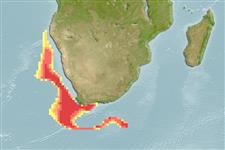>
Stomiiformes (Lightfishes and dragonfishes) >
Stomiidae (Barbeled dragonfishes) > Melanostomiinae
Etymology: Eustomias: Greek, eu = good + Greek, stoma = mouth (Ref. 45335); grandibulbus: Named for its large distal bulb; noun in apposition..
Environment: milieu / climate zone / depth range / distribution range
Ecología
marino; rango de profundidad 0 - 112 m (Ref. 58018). Subtropical
Southeast Atlantic: west of Cape Town, South Africa.
Tamaño / Peso / Age
Maturity: Lm ? range ? - ? cm
Max length : 16.0 cm TL macho / no sexado; (Ref. 3984)
Short description
Morfología | Morfometría
Espinas dorsales (total): 0; Radios blandos dorsales (total): 26; Espinas anales 0; Radios blandos anales: 40; Vértebra: 67. Two terminal bulbs separated by a short interspace, shorter than length of distal bulb. Barbel 68% SL. Terminal filament long (20%), with a series of 5 long branches beginning a short distance (a distal bulb length) from bulb, all with small bulblets, none of which approaches the diameter of the filament. All branches with 1 or more short branches. Stem axis peppered with melanophores; lightly pigmented on axis between bulbs and in proximal part of filament. Number of middorsal paired spots under skin uncertain (obscure and diffuse in holotype) (Ref. 11333).
Known based on a single specimen taken at a depth between 0-112 m.
Life cycle and mating behavior
Madurez | Reproducción | Puesta | Huevos | Fecundidad | Larva
Gibbs, R.H. Jr., 1986. Melanostomiidae. p. 236-243. In M.M. Smith and P.C. Heemstra (eds.) Smiths' sea fishes. Springer-Verlag, Berlin. (Ref. 3984)
IUCN Red List Status (Ref. 130435)
Threat to humans
Harmless
Human uses
Más información
Nombres comunesSinónimosMetabolismoDespredadoresEcotoxicologíaReproducciónMadurezPuestaAgregación para la puestaFecundidadHuevosEgg development
Age/SizeCrecimientoLength-weightLength-lengthLength-frequenciesMorfometríaMorfologíaLarvaDinámica larvariaReclutamientoAbundanciaBRUVS
ReferenciasAcuiculturaPerfil de acuiculturaRazasGenéticaElectrophoresesheritabilidadEnfermedadesProcesamientoNutrientsMass conversion
ColaboradoresImágenesStamps, Coins Misc.SonidosCiguateraVelocidadTipo de nataciónSuperficie branquialOtolitosCerebrosVisión
Herramientas
Special reports
Download XML
Fuentes de Internet
Estimates based on models
Preferred temperature (Ref.
123201): 10.3 - 18.1, mean 16.9 °C (based on 10 cells).
Phylogenetic diversity index (Ref.
82804): PD
50 = 0.5000 [Uniqueness, from 0.5 = low to 2.0 = high].
Bayesian length-weight: a=0.00302 (0.00117 - 0.00783), b=3.12 (2.89 - 3.35), in cm total length, based on LWR estimates for this (Sub)family-body shape (Ref.
93245).
Nivel trófico (Ref.
69278): 4.2 ±0.8 se; based on size and trophs of closest relatives
Resiliencia (Ref.
120179): Alto, población duplicada en un tiempo mínimo inferior a 15 meses (Preliminary K or Fecundity.).
Fishing Vulnerability (Ref.
59153): Low vulnerability (10 of 100).
